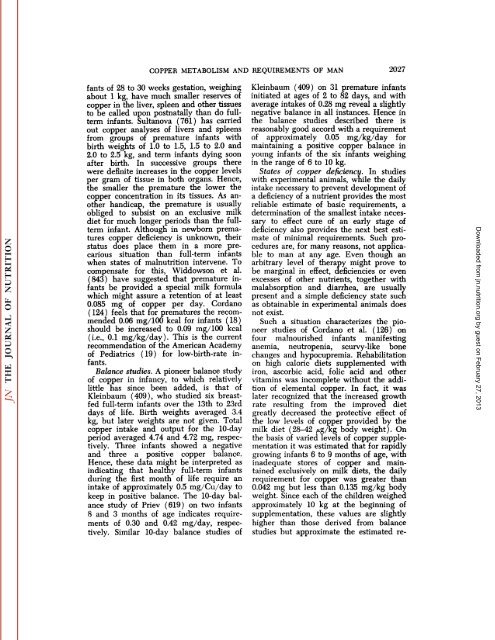conspectus of researchon copper metabolism and requirements
conspectus of researchon copper metabolism and requirements
conspectus of researchon copper metabolism and requirements
Create successful ePaper yourself
Turn your PDF publications into a flip-book with our unique Google optimized e-Paper software.
COPPER METABOLISM AND REQUIREMENTS OF MAN 2027<br />
fants <strong>of</strong> 28 to 30 weeks gestation, weighing<br />
about 1 kg, have much smaller reserves <strong>of</strong><br />
<strong>copper</strong> in the liver, spleen <strong>and</strong> other tissues<br />
to be called upon postnatally than do fullterm<br />
infants. Sultanova (761) has carried<br />
out <strong>copper</strong> analyses <strong>of</strong> livers <strong>and</strong> spleens<br />
from groups <strong>of</strong> premature infants with<br />
birth weights <strong>of</strong> 1.0 to 1.5, 1.5 to 2.0 <strong>and</strong><br />
2.0 to 2.5 kg, <strong>and</strong> term infants dying soon<br />
after birth. In successive groups there<br />
were definite increases in the <strong>copper</strong> levels<br />
per gram <strong>of</strong> tissue in both organs. Hence,<br />
the smaller the premature the lower the<br />
<strong>copper</strong> concentration in its tissues. As an<br />
other h<strong>and</strong>icap, the premature is usually<br />
obliged to subsist on an exclusive milk<br />
diet for much longer periods than the fullterm<br />
infant. Although in newborn prema<br />
tures <strong>copper</strong> deficiency is unknown, their<br />
status does place them in a more pre<br />
carious situation than full-term infants<br />
when states <strong>of</strong> malnutrition intervene. To<br />
compensate for this, Widdowson et al.<br />
(843) have suggested that premature in<br />
fants be provided a special milk formula<br />
which might assure a retention <strong>of</strong> at least<br />
0.085 mg <strong>of</strong> <strong>copper</strong> per day. Cordano<br />
( 124) feels that for prematures the recom<br />
mended 0.06 mg/100 kcal for infants (18)<br />
should be increased to 0.09 mg/100 kcal<br />
(i.e., 0.1 mg/kg/day). This is the current<br />
recommendation <strong>of</strong> the American Academy<br />
<strong>of</strong> Pediatrics ( 19) for low-birth-rate in<br />
fants.<br />
Balance studies. A pioneer balance study<br />
<strong>of</strong> <strong>copper</strong> in infancy, to which relatively<br />
little has since been added, is that <strong>of</strong><br />
Kleinbaum (409), who studied six breast<br />
fed full-term infants over the 13th to 23rd<br />
days <strong>of</strong> life. Birth weights averaged 3.4<br />
kg, but later weights are not given. Total<br />
<strong>copper</strong> intake <strong>and</strong> output for the 10-day<br />
period averaged 4.74 <strong>and</strong> 4.72 mg, respec<br />
tively. Three infants showed a negative<br />
<strong>and</strong> three a positive <strong>copper</strong> balance.<br />
Hence, these data might be interpreted as<br />
indicating that healthy full-term infants<br />
during the first month <strong>of</strong> life require an<br />
intake <strong>of</strong> approximately 0.5 mg/Cu/day to<br />
keep in positive balance. The 10-day bal<br />
ance study <strong>of</strong> Priev (619) on two infants<br />
8 <strong>and</strong> 3 months <strong>of</strong> age indicates require<br />
ments <strong>of</strong> 0.30 <strong>and</strong> 0.42 mg/day, respec<br />
tively. Similar 10-day balance studies <strong>of</strong><br />
Kleinbaum (409) on 31 premature infants<br />
initiated at ages <strong>of</strong> 2 to 82 days, <strong>and</strong> with<br />
average intakes <strong>of</strong> 0.28 mg reveal a slightly<br />
negative balance in all instances. Hence in<br />
the balance studies described there is<br />
reasonably good accord with a requirement<br />
<strong>of</strong> approximately 0.05 mg/kg/day for<br />
maintaining a positive <strong>copper</strong> balance in<br />
young infants <strong>of</strong> the six infants weighing<br />
in the range <strong>of</strong> 6 to 10 kg.<br />
States <strong>of</strong> <strong>copper</strong> deficiency. In studies<br />
with experimental animals, while the daily<br />
intake necessary to prevent development <strong>of</strong><br />
a deficiency <strong>of</strong> a nutrient provides the most<br />
reliable estimate <strong>of</strong> basic <strong>requirements</strong>, a<br />
determination <strong>of</strong> the smallest intake neces<br />
sary to effect cure <strong>of</strong> an early stage <strong>of</strong><br />
deficiency also provides the next best esti<br />
mate <strong>of</strong> minimal <strong>requirements</strong>. Such pro<br />
cedures are, for many reasons, not applica<br />
ble to man at any age. Even though an<br />
arbitrary level <strong>of</strong> therapy might prove to<br />
be marginal in effect, deficiencies or even<br />
excesses <strong>of</strong> other nutrients, together with<br />
malabsorption <strong>and</strong> diarrhea, are usually<br />
present <strong>and</strong> a simple deficiency state such<br />
as obtainable in experimental animals does<br />
not exist.<br />
Such a situation characterizes the pio<br />
neer studies <strong>of</strong> Cordano et al. ( 126) on<br />
four malnourished infants manifesting<br />
anemia, neutropenia, scurvy-like bone<br />
changes <strong>and</strong> hypocupremia. Rehabilitation<br />
on high caloric diets supplemented with<br />
iron, ascorbic acid, folie acid <strong>and</strong> other<br />
vitamins was incomplete without the addi<br />
tion <strong>of</strong> elemental <strong>copper</strong>. In fact, it was<br />
later recognized that the increased growth<br />
rate resulting from the improved diet<br />
greatly decreased the protective effect <strong>of</strong><br />
the low levels <strong>of</strong> <strong>copper</strong> provided by the<br />
milk diet (28-42 ,ug/kg body weight). On<br />
the basis <strong>of</strong> varied levels <strong>of</strong> <strong>copper</strong> supple<br />
mentation it was estimated that for rapidly<br />
growing infants 6 to 9 months <strong>of</strong> age, with<br />
inadequate stores <strong>of</strong> <strong>copper</strong> <strong>and</strong> main<br />
tained exclusively on milk diets, the daily<br />
requirement for <strong>copper</strong> was greater than<br />
0.042 mg but less than 0.135 mg/kg body<br />
weight. Since each <strong>of</strong> the children weighed<br />
approximately 10 kg at the beginning <strong>of</strong><br />
supplementation, these values are slightly<br />
higher than those derived from balance<br />
studies but approximate the estimated re-<br />
Downloaded from<br />
jn.nutrition.org<br />
by guest on February 27, 2013
















